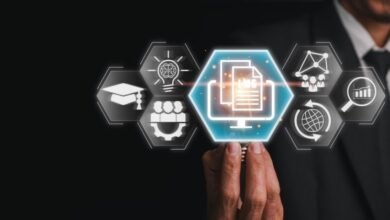How A Continuous Growth Culture Helps Employees Succeed


Why Lifelong Learning And Continuous Growth Are Vital In Today’s Workplace
In today’s rapidly evolving workplace landscape, the concept of lifelong learning has become more than just a buzzword—it’s a fundamental pillar of organizational success. As Learning and Development professionals, we understand the vital role that continuous growth plays in fostering a culture of innovation, adaptability, and excellence within our organizations. Cultivating a culture of continuous learning is not just about providing training opportunities; it’s about instilling a mindset that values curiosity, exploration, and ongoing development at every level of the organization. By embracing lifelong learning as a core organizational value, we empower employees to stay ahead of the curve, drive meaningful change, and thrive in an ever-changing world.
Cultivating Collaborative Learning Communities: Empowering Peer Knowledge Exchange
To foster continuous learning, creating collaborative learning communities is pivotal. Learning and Development professionals recognize the transformative potential of harnessing the collective wisdom and expertise of employees. By creating spaces and platforms where individuals can share insights, experiences, and best practices, organizations not only facilitate skill development but also foster a sense of camaraderie and mutual support among employees. Cultivating collaborative learning communities encourages a culture of curiosity, collaboration, and innovation, where every member has the opportunity to contribute, learn from others, and grow together toward shared goals.
Best Practices For Cultivating Learning Communities
- Foster a culture of trust and psychological safety where members feel comfortable sharing ideas and feedback.
- Create a supportive environment that values diversity of thought, backgrounds, and perspectives.
- Provide access to resources, tools, and materials that facilitate collaboration and knowledge sharing.
- Assign roles and responsibilities within the community to ensure accountability and promote teamwork.
- Organize regular meetings, workshops, or events to facilitate face-to-face interaction and relationship building.
Harnessing Mentorship And Coaching Initiatives: Nurturing Continuous Growth And Development
In the pursuit of cultivating a culture of continuous learning in the workplace, harnessing mentorship and coaching initiatives emerges as a cornerstone for nurturing ongoing development among employees. By establishing structured programs that pair seasoned professionals with less experienced colleagues, organizations can create valuable opportunities for knowledge transfer, skill development, and career growth. These initiatives not only provide mentees with personalized guidance and support but also offer mentors the chance to refine their leadership skills and contribute to the professional development of their peers. Through mentorship and coaching, employees gain access to valuable insights, feedback, and advice, fostering a culture of collaboration, growth, and continuous improvement within the organization.
Best Practices For Developing Mentorship And Coaching Initiatives
- Match mentors and mentees based on goals, interests, and areas for development.
- Encourage regular meetings and check-ins to track progress and address challenges.
- Create a structured framework or curriculum for mentoring sessions.
- Provide resources and tools for mentors and mentees to track progress and set goals.
- Recognize and celebrate the achievements and milestones of mentoring relationships.
Recognizing Progress: Inspiring Motivation Through Celebration Of Learning Milestones
Recognizing progress and celebrating learning milestones play pivotal roles in inspiring motivation and engagement among employees. Acknowledging and commemorating achievements, whether they are completing a training program, earning a certification, or mastering a new skill, not only validates the efforts of individuals but also reinforces the organization’s commitment to personal and professional development.
By shining a spotlight on learning milestones, organizations not only boost morale and motivation but also cultivate a sense of pride and accomplishment among employees, spurring them to pursue further growth opportunities with enthusiasm and dedication. Recognizing progress serves as a powerful catalyst for sustaining momentum and nurturing a culture where learning is valued, celebrated, and integrated into the fabric of everyday work life.
Best Practices For Celebrating Learning Milestones
- Use virtual communication tools to send digital high-fives or applause emojis to congratulate employees on their learning milestones.
- Celebrate learning milestones in team meetings or company-wide forums to foster a sense of community and shared success.
- Have leaders publicly acknowledge and commend employees for their dedication to learning and growth.
- Share stories of how employees’ learning journeys have positively impacted their work or the organization as a whole.
- Make recognition of learning milestones an ongoing practice rather than a one-time event, reinforcing the importance of continuous learning and growth in the workplace.
Investing In Employee Growth: Supporting Further Education And Certification Pursuits
Investing in employee growth through supporting further education and certification pursuits is essential for fostering a culture of continuous learning in the workplace. By providing opportunities for employees to enhance their knowledge and skills, organizations demonstrate a commitment to their professional development and advancement. Additionally, investing in employee growth cultivates a culture of continuous improvement and innovation, as individuals bring new insights and expertise back to the organization, driving performance and competitiveness in today’s dynamic business landscape.
Best Practices For Offering Support For Employee Growth
- Provide tuition reimbursement or financial assistance for employees pursuing higher education or certifications.
- Offer flexible work hours or study leave to accommodate employees’ learning schedules.
- Encourage managers to support employees’ educational pursuits and incorporate learning goals into performance evaluations.
- Host informational sessions or workshops to help employees explore different educational and certification options.
- Encourage employees to share their knowledge and insights with colleagues through presentations or workshops.
Embracing Failure As Fuel: Cultivating A Culture Of Learning And Innovation
Embracing failure as fuel is paramount to fostering innovation and growth. Rather than viewing failure as a setback, organizations should encourage employees to see it as a stepping stone to success. By creating an environment where experimentation and risk-taking are not only accepted but also celebrated, employees feel empowered to push boundaries, explore new ideas, and learn from their mistakes. This mindset shift from fearing failure to embracing it as an opportunity for learning and improvement not only enhances individual resilience but also drives organizational innovation. When failure is destigmatized and seen as a natural part of the learning process, employees are more inclined to take calculated risks, innovate boldly, and ultimately contribute to the organization’s long-term success.
Best Practices For Embracing Failure
- Foster a growth mindset that views failure as a natural part of the learning process.
- Recognize and celebrate learning opportunities that arise from failure.
- Offer rewards and recognition for creative problem-solving and adaptive thinking.
- Provide training on resilience and coping strategies to help employees navigate setbacks.
- Encourage experimentation through pilot projects and innovation initiatives.
Reflect, Learn, Grow: Continuous Growth Through Regular Goal Setting And Reflection
Encouraging employees to set achievable yet challenging goals, organizations empower individuals to take ownership of their development journey. Regular reflection on progress allows employees to assess their achievements, identify areas for growth, and adjust their strategies accordingly. This iterative process not only fosters personal and professional development but also contributes to a culture of continuous learning within the workplace. By embracing “reflect, learn, grow” as a guiding principle, organizations can instill a mindset of continuous improvement, adaptability, and resilience among their workforce, ultimately driving innovation and success.
Best Practices For Goal Setting And Reflection
- Provide training on effective goal-setting techniques.
- Promote accountability by encouraging employees to track their progress.
- Regularly revisit and revise goals based on progress and changing circumstances.
- Encourage employees to seek feedback from peers, supervisors, and mentors.
- Offer workshops or training sessions on reflection techniques.
Source link





